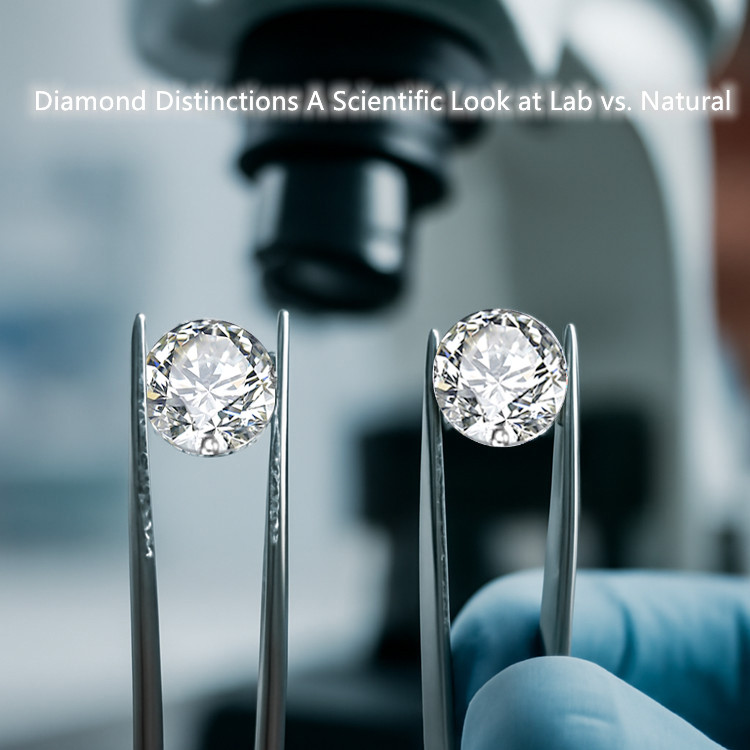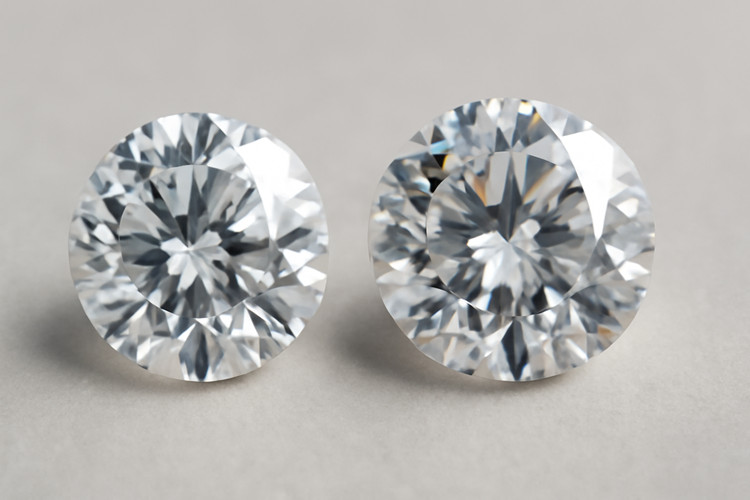
Diamonds have long been revered as one of the most valuable and mesmerizing materials known to humanity. Whether found deep within the Earth or cultivated in controlled laboratory environments, these gemstones embody beauty, rarity, and luxury.
However, the advent of lab-grown diamonds in recent years has stirred much debate in the gemological world. While some people still cling to the idea that only natural diamonds hold true value, scientific advancements have shown that lab-grown diamonds are chemically and physically indistinguishable from their natural counterparts.
In this article, we will delve into the scientific aspects of both types of diamonds—comparing their chemical structures, physical properties, and compositions—to better understand their similarities and differences.
What Makes a Diamond a Diamond?
To begin, it is essential to understand what makes diamonds unique on a molecular level. Both natural and lab-grown diamonds are made of pure carbon, arranged in a crystal lattice structure known as the diamond cubic structure. This arrangement of carbon atoms forms a network of tetrahedra, with each carbon atom bonded to four neighboring carbon atoms in a three-dimensional matrix.
Chemical Composition:
Both natural and lab-grown diamonds are 100% pure carbon, but the way this carbon is arranged and the conditions under which they are formed vary significantly.
Natural Diamonds:
These diamonds are formed over billions of years under extreme pressure and temperature conditions deep within the Earth's mantle. Carbon atoms crystallize in a highly structured manner, and the process is slow, allowing for the creation of large crystals.
Lab-Grown Diamonds:
On the other hand, lab-grown diamonds are produced in laboratories using methods such as Chemical Vapor Deposition (CVD) or High Pressure High Temperature (HPHT) techniques.
These methods replicate the natural processes but occur over a much shorter timespan. Lab-grown diamonds have the same molecular structure as natural diamonds, which is why they are often referred to as "chemical brothers."
The Formation Process: Earth vs. Laboratory

Natural Diamond Formation:
Natural diamonds are formed under intense geological pressure at depths of 140 to 190 kilometers beneath the Earth's surface. Over millions of years, carbon atoms are subjected to extreme heat (around 1,300°C to 1,600°C) and pressure (about 45 to 60 kilobars). This slow process allows the carbon atoms to bond in a highly stable arrangement, forming the crystalline structure we recognize as a diamond.
The natural diamond formation process also involves the introduction of various trace elements, such as nitrogen and boron, which can give diamonds their distinctive colors. Nitrogen impurities often result in yellow or brown diamonds, while boron can give diamonds a blue hue.
Lab-Grown Diamond Formation:
In contrast, lab-grown diamonds are produced in a fraction of the time, typically weeks or months, under controlled laboratory conditions. The two main methods used for creating lab-grown diamonds are:
Chemical Vapor Deposition (CVD):
In this process, carbon-rich gases (usually methane) are introduced into a vacuum chamber where the carbon atoms are excited into a plasma state. These atoms then deposit on a substrate, gradually building up layer by layer to form a diamond crystal.
High Pressure High Temperature (HPHT):
This method mimics the extreme pressure and temperature conditions of the Earth's mantle. A small diamond seed is placed in a chamber with carbon and exposed to pressures of around 5 GPa and temperatures of 1,300°C to 1,600°C. This method allows for the creation of diamonds that are nearly identical to their natural counterparts.
Despite the differences in the processes, both natural and lab-grown diamonds end up with the same atomic structure, making them nearly identical in terms of physical properties.
Physical Properties: Are They Really the Same?
Many consumers remain skeptical about the quality and value of lab-grown diamonds compared to natural ones. However, from a scientific perspective, both types of diamonds exhibit the same physical properties.
Hardness:
One of the most defining features of diamonds is their exceptional hardness. Diamonds are the hardest known natural material on the Mohs scale of hardness, scoring a perfect 10. This hardness is due to the strong covalent bonds between the carbon atoms in the diamond lattice. Whether formed in the Earth or a laboratory, both natural and lab-grown diamonds exhibit the same hardness, making them equally durable and scratch-resistant.
Light Refraction:
Diamonds are famous for their brilliance, which is caused by the refraction of light through the crystal. The diamond’s ability to bend light, creating the familiar "fire" or dispersion of colors, is a result of its high refractive index and dispersion properties. These properties are governed by the arrangement of the carbon atoms in the crystal lattice, which is identical in both natural and lab-grown diamonds.
Density:
The density of a diamond is another important physical property, which is determined by its mass and volume. Natural and lab-grown diamonds have nearly identical densities, typically around 3.51 g/cm³. While both diamonds may contain trace elements or inclusions, these do not significantly affect the overall density.
Inclusions and Impurities:
One area where natural diamonds and lab-grown diamonds can differ is in the presence of inclusions or impurities. Natural diamonds often contain inclusions, which are tiny imperfections formed during their formation deep within the Earth.
These inclusions can be gas bubbles, minerals, or other particles trapped within the diamond crystal. These inclusions are unique to each diamond and can be used to identify natural diamonds.
Lab-grown diamonds, on the other hand, tend to have fewer inclusions, but they may exhibit certain growth patterns specific to the synthetic process. For example, diamonds grown using the CVD method can display "pinpoint" inclusions, while HPHT diamonds might show "graining" patterns.
Chemical Brothers: The Same but Different?
Despite the differences in formation, the chemical composition of natural and lab-grown diamonds is identical. Both types of diamonds are composed entirely of carbon atoms arranged in a diamond lattice. This means that, at the molecular level, there is no distinguishing between the two types.
One area where distinctions can be made is in the trace elements or isotopes found within the diamond. Natural diamonds often contain isotopic variations, such as carbon-13 and carbon-14, which are rare in lab-grown diamonds. Additionally, certain trace elements, such as nitrogen, may be present in different concentrations in natural diamonds compared to lab-grown ones. These differences, however, are typically detectable only by specialized equipment and do not affect the diamond's overall appearance, durability, or value.
Myth Busting: Addressing Common Misconceptions
Misconception #1: Lab-Grown Diamonds Are Not "Real" Diamonds
This is perhaps the most common misconception about lab-grown diamonds. While it’s true that lab-grown diamonds are created in a laboratory rather than naturally occurring, they are still chemically and physically identical to natural diamonds. The term "real" can be misleading because, scientifically speaking, both natural and lab-grown diamonds are genuine diamonds.
Misconception #2: Lab-Grown Diamonds Are Inferior in Quality
Another misconception is that lab-grown diamonds are of inferior quality compared to natural diamonds. In reality, lab-grown diamonds can be made to have the same clarity, color, and carat weight as natural diamonds, and in some cases, they may even have fewer inclusions. Furthermore, lab-grown diamonds can be produced with a higher degree of consistency, which allows for better control over the final product’s characteristics.
Misconception #3: Lab-Grown Diamonds Are Less Valuable
While lab-grown diamonds typically cost less than their natural counterparts, this does not mean they are less valuable. Lab-grown diamonds can be just as durable, beautiful, and long-lasting as natural diamonds. The price difference is primarily due to the cost of production, which is lower for lab-grown diamonds due to the shorter formation process.
Conclusion: The Future of Diamonds
In conclusion, loose lab diamonds and natural diamonds are truly "chemical brothers," sharing the same molecular structure and physical properties. The primary difference lies in their formation—one occurring deep within the Earth over millions of years, the other in a controlled laboratory environment in just a fraction of the time.
Both types of diamonds offer the same beauty, durability, and brilliance, making them equally valuable, depending on the consumer’s preferences. As the technology behind lab-grown diamonds continues to advance, they will undoubtedly become a more prominent player in the gemstone market, offering consumers an ethical and sustainable alternative to mined diamonds.











